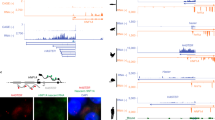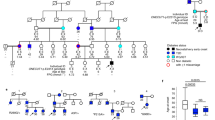Abstract
Maturity-onset diabetes of the young type 3 (MODY3) results from mutations in the transcriptional activator hepatocyte nuclear factor-1α (HNF-1α). Several MODY3 mutations target the HNF-1α dimerization domain (HNF-p1), which binds the coactivator, dimerization cofactor of HNF-1 (DCoH). To define the mechanism of coactivator recognition and the basis for the MODY3 phenotype, we determined the cocrystal structure of the DCoH–HNF-p1 complex and characterized biochemically the effects of MODY3 mutations in HNF-p1. The DCoH–HNF-p1 complex comprises a dimer of dimers in which HNF-p1 forms a unique four-helix bundle. Through rearrangements of interfacial side chains, a single, bifunctional interface in the DCoH dimer mediates both HNF-1α binding and formation of a competing, transcriptionally inactive DCoH homotetramer. Consistent with the structure, MODY3 mutations in HNF-p1 reduce activator function by two distinct mechanisms.
This is a preview of subscription content, access via your institution
Access options
Subscribe to this journal
Receive 12 print issues and online access
$189.00 per year
only $15.75 per issue
Buy this article
- Purchase on Springer Link
- Instant access to full article PDF
Prices may be subject to local taxes which are calculated during checkout




Similar content being viewed by others
Accession codes
References
Struhl, K. Cell 98, 1–4 (1999).
Myers, L.C., Gustafsson, C.M., Hayashibara, K.C., Brown, P.O. & Kornberg, R.D. Proc. Natl. Acad. Sci. USA 96, 67–72 (1999).
Naar, A.M. et al. Nature 398, 828–832 (1999).
Rojas, J.R. et al. Nature 401, 93–98 (1999).
Perini, G., Oetjen, E. & Green, M.R., J. Biol. Chem. 274, 13970–13977 (1999).
Perini, G., Wagner, S. & Green, M.R. Nature 376, 602–605 (1995).
Riese, J. et al. Cell 88, 777–787 (1997).
Luo, Y., Ge, H., Stevens, S., Xiao, H. & Roeder, R.G. Mol. Cell. Biol. 18, 3803–3810 (1998).
Mendel, D.B. et al. Science 254, 1762–1767 (1991).
Emens, L.A., Landers, D.W. & Moss, L.G. Biochemistry 89, 7300–7304 (1992).
Mendel, D.B. & Crabtree, G.R. J. Biol. Chem. 266, 677–680 (1991).
Citron, B.A. et al. Proc. Natl. Acad. Sci. USA 89, 11891–11894 (1992).
De Francesco, R., Pastore, A., Vecchio, G. & Cortese, R. Biochemistry 30, 143–147 (1991).
Cronk, J.D. Structural studies of DCoH, a bifunctional enzyme and protein-binding transcriptional coactivator. (Ph.D. Thesis, University of California, Berkeley; 1996).
Holm, L. & Sander, C. J. Mol. Biol. 233, 123–138 (1993).
Hua, Q. et al. Proc. Natl. Acad. Sci. USA 97, 1999–2004 (2000).
Pastore, A. et al. Biochemistry 30, 148–153 (1991).
Pastore, A., De Francesco, R., Castiglione, M.M.A., Nalis, D. & Cortese, R. Protein Eng. 5, 749–757 (1992).
Nicosia, A. et al. Cell 61, 1225–1236 (1990).
Endrizzi, J.A., Cronk, J.D., Weidong, W., Crabtree, G.R. & Alber, T., Science 268, 556–559 (1995).
Johnen, G. & Kaufman, S. Proc. Natl. Acad. Sci. USA 94, 13469–13474 (1997).
Ficner, R., Sauer, U.H., Stier, G. & Suck, D. EMBO J 14, 2034–2042 (1995).
Eckert, D.M., Malashkevich, V.N., Hong, L.H., Carr, P.A. & Kim, P.S. Cell 99, 103–115 (1999).
McWhirter, S.M. et al. Proc. Natl. Acad. Sci. USA 96, 8408–8413 (1999).
Ye, H., Park, Y.C., Kreishman, M., Kieff, E. & Wu, H., Mol. Cell 4, 321–330 (1999).
Cronk, J.D., Endrizzi, J.A. & Alber, T. Protein Sci. 5, 1963–1972 (1996).
Rebrin, I., Thöny, B., Bailey, S.W. & Ayling, J.E. Biochemistry 37, 11246–11254 (1998).
Koster, S. et al. Eur. J. Biochem. 241, 858–864 (1996).
Rhee, K., Stier, G., Becker, P.B., Suck, D. & Sandaltzopoulos, R. J. Mol. Biol. 265, 20–29 (1997).
Radhakrishnan, I. et al. Cell 1997, 741–752 (1997).
Darimont, B.D. et al. Genes Dev. 12, 3343–3356 (1998).
Nolte, R.T. et al., Nature 395, 137–143 (1998).
De Vos, A.M., Ultsch, M. & Kossiakoff, A.A. Science 255, 306–312 (1992).
Yamagata, K. et al. Nature 384, 455–458 (1996).
Iwasaki, N. et al. Diabetes 46, 1504–1508 (1997).
Boutin, P. et al. Diabetes 46, 2108–2109 (1997).
Ng, M.C. et al. Diabetic Med. 16, 956–963 (1999).
Kuo, C.J. et al. Nature 355, 457–461 (1992).
Gragnoli, C. et al. Diabetes 46, 1648–1651 (1997).
Van Duyne, G.D., Standaert, R.F., Karplus, P.A., Schreiber, S.L. & Clardy, J. J. Mol. Biol. 229, 105–124 (1993).
Leslie, A.G.W., Brick, P. & Wonacott, A. Daresbury Lab. Information Quart. Protein Crystallogr. 18, 33–39 (1986).
Knight, S. Rubulose 1,5-bisphosphate carboxylase/oxygenase — a structural study (PhD Thesis Swedish University of Agricultural Sciences Uppsala; 1989).
La Fortelle, E. & Bricogne, G. Methods Enzymol. 276, 472–494 (1997)
Jones, T.A., Zhou, J.Y., Cowan, S.W. & Kjeldgaard, M. Acta Crystallogr. A 47, 110–119 (1991).
Brünger, A.T. et al. Acta Crystallogr. D 54, 905–921 (1998).
Lassar, A.B. et al. Cell 66, 305–315 (1991).
Acknowledgements
We thank D.S. King for peptide synthesis and mass spectrometry. Data were collected at the Stanford Synchrotron Radiation Laboratory (SSRL) with the help of H. Bellamy. SSRL is operated by the Department of Energy, Office of Basic Energy Sciences. The SSRL Biotechnology Program is supported by the NIH National Center for Research Resources. R.B.R. was supported by postdoctoral fellowships from the NIH and the Juvenile Diabetes Foundation International. This research was supported by a grant from the NIH (T.A.).
Author information
Authors and Affiliations
Corresponding author
Rights and permissions
About this article
Cite this article
Rose, R., Bayle, J., Endrizzi, J. et al. Structural basis of dimerization, coactivator recognition and MODY3 mutations in HNF-1α. Nat Struct Mol Biol 7, 744–748 (2000). https://doi.org/10.1038/78966
Received:
Accepted:
Issue Date:
DOI: https://doi.org/10.1038/78966



